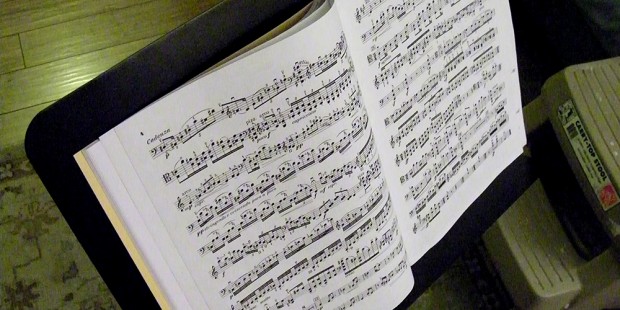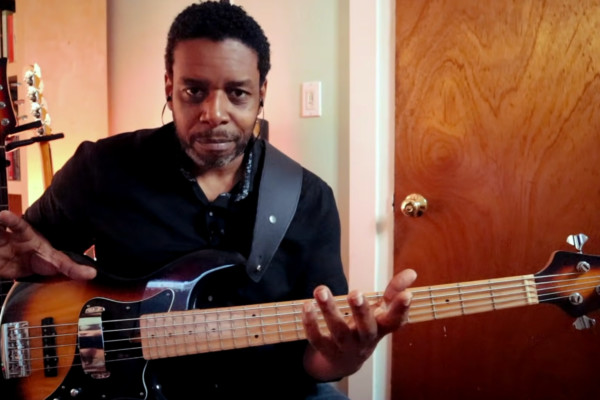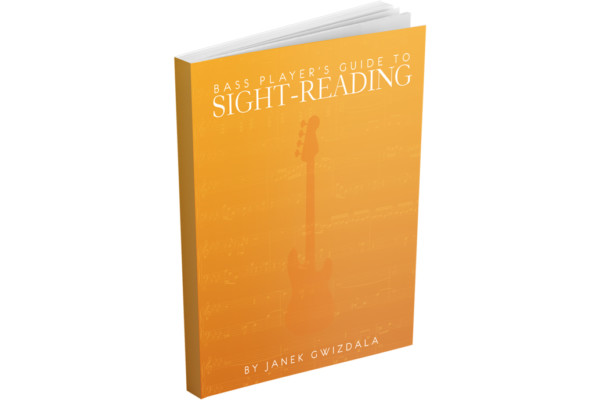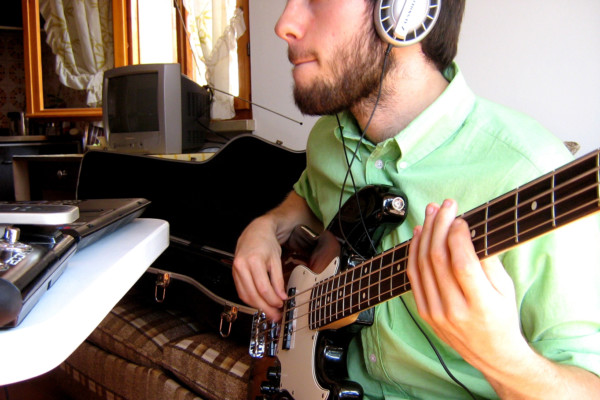Sight Reading for Auditions: Tips for Bass Players

Q: I’m a bassist starting my last year in high school now. I really feel that I need to become a sight reader as quickly as possible due to an upcoming audition for the music university I wish to attend. A friend of mine did the audition and they ended up handing him some crazy bebop tune – not close to what he had expected. Any advice on how to take those giant steps?
A: Typically, in any audition, you can expect that they’ll want to test your limits, so it is their intention to slowly increase the difficulty level to see what you know as well as how you deal with it.
For example, nobody would throw an up-tempo bebop head in front of you and expect you to sight read it without making any mistakes. Likely, they are more interested in seeing how much of it you can play and once you get tangled up, if you can keep your place with the music, recover and continue playing through.
In other words, do you have enough experience to make a mistake and not completely fall apart?
With this in mind, you’ll understand why I say that there is no fast way to learn how to sight read. It is a skill that takes incremental development and constant maintenance.
In short, it’s too late to cram over the summer. But every step you take now will help you in the audition and in the future.
The first step is to learn both the notes of the staff and the notes on your fretboard.
I usually start students with simple melodies, scale patterns and linear classical pieces. Linear lines can help since they don’t jump around the staff too much and you can learn by referencing what you already know.
For example, if you know that this note is C and you see the next note is one line above that space, then you can quickly begin to associate that middle line with D.
Learning to read notation really is kind of a “one note at a time” skill. Because of this referential style of internalization, it is important that you work at it daily so you don’t forget what you began to internalize the day before.
Don’t worry too much about the audition process. They don’t expect you to have everything together. Otherwise, you wouldn’t need them!
They just want to know where you are so they know where you will need to begin in their program. You can only prepare so much for what you don’t know is coming. All you can do is really work to nail the stuff you’ve prepared and to have started to consider some of the material you know you will need to learn in school.
All of music and performance is pretty much adherent to this rule: there are no shortcuts. It takes thousands of hours to become masterful and at least hundreds of hours to begin to get pretty good.
Don’t let that dissuade you though. I find it comforting to know that all I need to do to improve is, simply, to continue trying!
Readers, how about you? What have you done to improve your sight reading? Tell us about it in the comments.
Have a question for Damian Erskine? Send it to [email protected]. Check out Damian’s instructional books, Right Hand Drive and The Improviser’s Path.




One thing I’ve found is that it can be helpful to start with rhythms only – especially with someone who already has good knowledge of the instrument and is learning to sight read later. I take some simple drum charts with students and get them to learn rhythms first. There are also some rhythm only books out there – I can’t think of any particular ones at this moment, but you should be able to find them in a store that caters to band instruments.
Make sight reading part of your practice regimen. If you can read well, you can work.
I’ve found that learning RHYTHM is key…then learn the notes on the staff and fretboard. Start with the first position and start reading walking basslines at slow tempo (80 bpm for example). There are apps that you can d/l that will help. I actually do some practicing in the gym on an exercise bike where I just tap out rhythms and notes on my iPad. Then I just apply it all on the instrument when I get home from work. I’ve made huge jumps in about a month’s time.
Yeah, the key is being patient, especially if you already know how to play.I found the best way was learning figures as well…In bass music the same figures have a tendency to show up quite a bit and after a while you start recognizing the figures much faster….that definitely helped me…along with playing trombone before bass! :-)
Related to Dwight’s advice, you may want to check out Rich Appleman’s sight reading practice book: http://www.berkleepress.com/catalog/product?product_id=11179.
Also Louis Bellson has a book of just rhythms that’s good for reading practice. Can’t remember the title.
I teach my students to transcribe… learning to read by writing… and have had great success.
I have to admit that when I was in college, a classical musician wasn’t required to sight read. We had prepared audition pieces (the college I went to, the University of North Carolina at Greensboro, did not have a jazz major at the time). But I went in for the jazz band audition and it was all sight reading – 2 tough Stan Kenton tunes and 2 others that I don’t remember now. Three pieces were totally written out bass lines and 2 were only chord charts with a piano player for me to accompany. This was a straight up competition, not the situation that Damien describes. It was a nail biter since the tunes weren’t any standards I knew at the time. But in the end, I won the spot and kept it for 4 years. There are some tricks to such an audition but there isn’t space for that here.
I’ts simple: read a new song everyday and not necesary bass lines, can be the Real Book bass clef, bach cello suites or tronbone etudes, i like to take a sax solo and try to play it, like parker , brecker , trane, great post damian, greetings from Chile.
I agree with Jackie. The same figures seem to show up more and more the more you do it. It’s like anything else. Just do it a lot and it becomes ingrained. I also think there’s a great benefit to sight singing. There’s a lot going on with instrument in hand. The actual reading, negotiating positions on the bass, subdividing the beat, etc. Start away from the instrument at first and work on getting the intervals and rhythms together. Then try it with your bass. It definitely helps to have the notes on the fretboard internalized. Not just being able to find the notes, but to have your hand go to each note without looking or thinking about it.
I highly recommend Carole Kaye’s methodology. Also, pick up any bass transcription book that comes with a CD and check yourself after trying to sight read the chart.
From my own experience, practice is essential. There have been numerous debates on the “right” or the most appropriate sight reading methodology. An interesting and efficient approach for me is “SightRead4BowedStrings” app on iPad where once a bar has been played it disappears forcing the brain and the eye to look only forward. I guess this is all about it, be aware of what follows at all times. Exercises available for all grades.
The website to look on is http://www.sightread4.com.
I can hear the groans already but I recommend getting a copy of the Bach Cello Suites? Why? 1) You can practice reading sophisticated harmonies that cover a good range of the fingerboard; 2) If you have a 5-string bass, even better as you’ll be able to put those low notes to use on the B string; 3) Probably “down the road” for some players, but you can practice transposing the movements into other keys by reading them in different clefs. For example, I’m working on the Prelude to the 5th Suite. It’s written in C minor but I read it as written in tenor clef like it’s Gmin, and I just started working on it in Amin, as if it’s written in treble clef. 4) Bach, any Bach, will get you going on mastering your instrument, whether it’s bass or electric. You have double-stops, triple-stops, and all kinds of modulations. Bach is basically 18th jazz without the saxes and drums…
Yes, Bach cello suites are great for reading practice.
Great article, and even better advice…[email protected]
My experience of sight-reading for an audition was to play along with a pre-recorded track that was just the kind of track I’d have to play along with on the gig. I ran into several problems, since there were tempo and meter changes and no conductor to indicate them. That said, I was told that I could probably get a position in spite of the problems I had on the audition — I clearly could read music pretty well.
But sight-reading is a highly specialized pursuit, and not generally a well-paid one — you have to be top notch at it to be paid what your worth when you’re doing it, as on a television show or in the Cirque du Soleil. And even then, you’d better be a union member, etc. Otherwise you’re playing in the pit in a community theater or on a cruise ship. There is money in that, but unless you’re already a good reader, perhaps not enough to develop the chops for it, unless you really like that sort of thing.
I get hired for musicals and big bands because I can sight read well.
I’ve been reading all my life. I don’t practice reading, I just read. I will buy a music book and read my way through it.
One thing that is helpful is to sing the music (or part of it) before you try to play it.
Singing bass in a choir would be helpful.
Just learning note names and where they are on your instrument is only the first part. You want to build to a point where you can hear the music in your head before you play it.
All great advise here, what really helps me are APPs on my iPhone! The ones I use most are free and make learning the fretboard and sight reading into games with options to start simple and build. Best part is I use these during my daily 2+ hrs train commute, supplementing my hands-on playing time and keeping it fun!
There are a lot of great suggestion here. The only thing I would add is it helps to clap the rhythm that you are trying to play. Before we could enter the advanced band in high school, the band teacher would test on 2 pages of one-line rhythms. Each progressively hard. You write under the note what the rhythm is, then clap it.
Thank you very much for this. I’m one who really appreciates the straight-skinny.
I’m hardly a strong sight reader but I’ve been taking it seriously since I started college (pop music college with very little emphasis on sight reading, really start us from the bottom up), and I’ve found working myself through the James Jamerson book by Dr. Licks is taking me a long way. You can develop like Jamerson through from his 8th note early days into his heavily chromatic and syncopated 16th note latter years. Also, they’re all great tunes!! It’s a great feeling when you get them up to speed and can play those pop repertoire classics :D